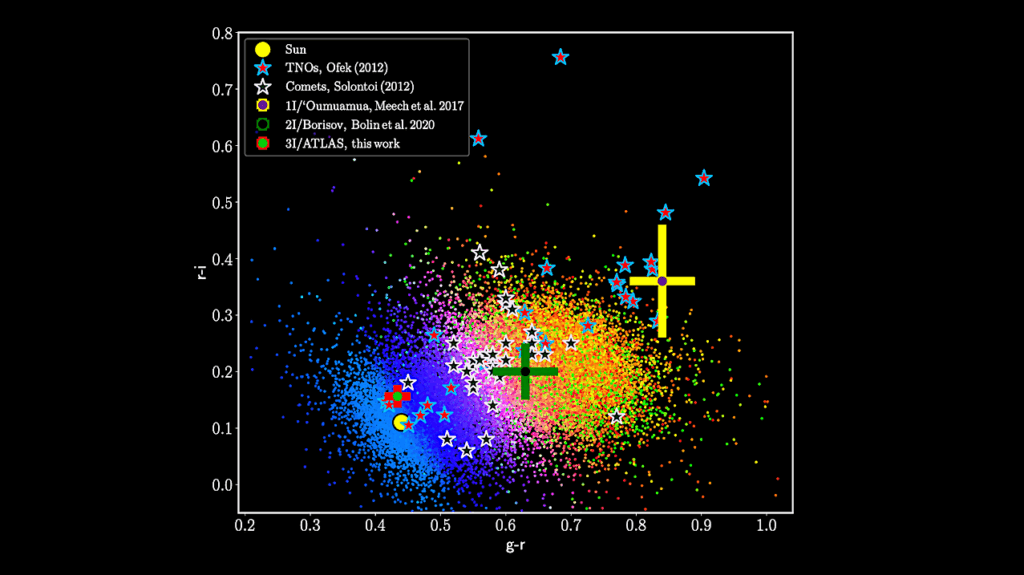Interstellar Object 3I/ATLAS May Be The Oldest Comet Ever Seen

A mystery interstellar object discovered last week is likely to be the oldest comet ever seen – possibly predating our solar system by more than three billion years, researchers say.
The “water ice-rich” visitor, named 3I/ATLAS, is only the third known object from beyond our solar system ever spotted in our cosmic neighbourhood and the first to reach us from a completely different region of our Milky Way galaxy.
It could be more than seven billion years old, according to University of Oxford astronomer Matthew Hopkins – who is discussing his findings at the Royal Astronomical Society’s National Astronomy Meeting 2025 in Durham – and may be the most remarkable interstellar visitor yet.
Unlike the previous two objects to enter our solar system from elsewhere in the cosmos, 3I/ATLAS appears to be travelling on a steep path through the galaxy, with a trajectory that suggests it originated from the Milky Way’s ‘thick disk’ – a population of ancient stars orbiting above and below the thin plane where the Sun and most stars reside.
“All non-interstellar comets such as Halley’s comet formed with our solar system, so are up to 4.5 billion years old,” Hopkins said.
“But interstellar visitors have the potential to be far older, and of those known about so far our statistical method suggests that 3I/ATLAS is very likely to be the oldest comet we have ever seen.”
The object was first spotted on 1 July 2025 by the ATLAS survey telescope in Chile, when it was about 670 million km from the Sun.
Hopkins’ research predicts that, because 3I/ATLAS likely formed around an old, thick-disk star, it should be rich in water ice.
“This is an object from a part of the galaxy we’ve never seen up close before,” said Professor Chris Lintott, co-author of the study and presenter of the BBC’s The Sky at Night.
“We think there’s a two-thirds chance this comet is older than the solar system, and that it’s been drifting through interstellar space ever since.”
As it approaches the Sun, sunlight will heat 3I/ATLAS’s surface and trigger cometary activity, or the outgassing of vapour and dust that creates a glowing coma and tail.
Early observations already suggest the comet is active, and possibly larger than either of its interstellar predecessors, 1I/’Oumuamua (spotted in 2017) and 2I/Borisov (2019).
If confirmed, this could have implications for how many similar objects future telescopes, such as the new Vera C. Rubin Observatory, are likely to detect. It may also provide clues about the role that ancient interstellar comets play in seeding star and planet formation across the galaxy.

A side-on view of the Milky Way, showing the estimated orbits of both our Sun and the 3I/ATLAS comet. 3I/ATLAS is shown in red dashed lines, and the Sun is shown in yellow dotted lines. The large extent of 3I’s orbit vertically into the outer thick disk is clear, while the Sun stays nearer the plane of the galaxy. M. Hopkins/Ōtautahi-Oxford team. Base map: ESA/Gaia/DPAC, Stefan Payne-Wardenaar, CC-BY-SA 4.0 Licence type Attribution (CC BY 4.0)
“We’re in an exciting time: 3I is already showing signs of activity. The gases that may be seen in the future as 3I is heated by the Sun will test our model,” said co-author Dr Michele Bannister, of the University of Canterbury in New Zealand.
“Some of the biggest telescopes in the world are already observing this new interstellar object – one of them may be able to find out!”
The discovery of 3I caught the team by the surprise. It happened as they were gearing up for the beginning of survey operations with the Vera C. Rubin Observatory, which their model predicts will discover between 5 and 50 interstellar objects.
“The solar system science community was already excited about the potential discoveries Rubin will make in the next 10 years, including an unprecedented number of interstellar objects,” said co-researcher Dr Rosemary Dorsey, of the University of Helsinki.
“The discovery of 3I suggests that prospects for Rubin may now be more optimistic; we may find about 50 objects, of which some would be similar in size to 3I. This week’s news, especially just after the Rubin First Look images, makes the upcoming start of observations all the more exciting.”
The team’s findings come from applying a model developed during Hopkins’ doctoral research, which simulates the properties of interstellar objects based on their orbits and likely stellar origins.
Just a week before the comet’s discovery, Hopkins had defended his thesis, and when 3I/ATLAS was announced, he was set to go on holiday. Instead, he found himself comparing real-time data to his predictions.
“Rather than the quiet Wednesday I had planned, I woke up to messages like ‘3I!!!!!!!!!!’,” said Hopkins. “It’s a fantastic opportunity to test our model on something brand new and possibly ancient.”
Hopkins and his co-authors have published their analysis as a preprint on arXiv. Their model, dubbed the Ōtautahi–Oxford Model, marks the first real-time application of predictive modelling to an interstellar comet.
For those keen to catch a glimpse of 3I/ATLAS, it should be visible through a reasonably-sized amateur telescope in late 2025 and early 2026.
Astrobiology








